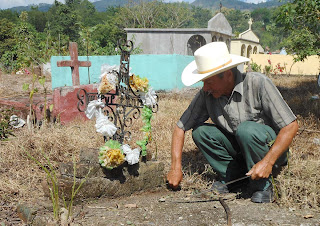It’s not often you’d describe a
graveyard as a beehive of activity, but the cemetery here in Copan has been
these past couple of days as the locals mark Dia de Los Difuntos.
Every Latin American country celebrates
the Day of the Dead – or Day of the Deceased, as it’s known here – in their own
way. In Honduras it’s a time for heading
down to the cemetery to do a big cleanup of your loved one’s grave. There can’t
be much budget in a poor country for maintenance staff at cemeteries, so it’s a
chance for family members to spruce things up while honouring the memory of the
mothers, fathers, grandparents and children buried there.
The Copan cemetery is a five-minute
walk from where I live, and I headed over early yesterday morning to check out the
activities. Some 15 families were already hard at work. Many more would
come over the course of the next two days.
Some families just needed to freshen
up the flowers a little or clear out a few weeds. But others were in the midst
of full-on construction projects – putting a new roof on a tomb, repainting,
finishing off a monument’s ceramic trim that they hadn’t been able to afford up
until now.
I was a bit apprehensive about
showing up with my camera like a big, gawky tourist. I contemplated trying to
sneak in a few shots, but thought that would be just plain disrespectful. So I asked people if it would be all right if I took a photo of them
working. Everybody was completely fine with that – happy, even.
I wandered around the small cemetery for longer
than I intended, feeling moved by the love and family connections that had
brought everybody there. Whether they
were tending to beautifully kept mausoleums or teeny crosses hand-painted with
a family member’s name, all of them were there to remember somebody who’d meant
a great deal to them. Every culture does that in their own way, but something
about seeing a man on his hands and knees pulling long grass away from his
wife’s grave really adds to the poignancy of the act.
We tend toward a more sanitized
version of remembering in Canada. My father’s ashes are in a beautifully kept
cemetery in Victoria marked with a perfectly lettered memorial plaque. I know
my mother was hurt that I never wanted to go to the memorial park to “visit”
him when we lived in Victoria, but it never felt like he was really there.
But walking past the Copan grave of
Fanny Carolina Leonor Garin, dead at the tender age of 28, watching the husband
she’d left behind lovingly restoring her grave to a vivid shade of turquoise–
well, I felt her there. I could feel Juan Antonio Lopez Jacinto in the scrawl of
his name painted on one end of his tomb. The dead were alive again in the faces
of their cheerful family members, who were busily scrubbing and sanding and reminiscing
about the people buried beneath their feet.
A Canadian memorial park is much,
much tidier and greener than the overgrown, dusty plot of land where Copanecos
bury their dead. Our dead in Canada exist amid a kind of hushed tranquility that
I associate with funeral homes and carefully managed sorrow.
But something about the sheer
disorder of the Copan cemetery feels so genuine. Death is messy and sad. All
the well-trimmed and verdant landscaping of a typical North American cemetery can’t
change that.
It was practically like hearing people’s
thoughts as I wandered through the graves in Copan.
My neighbour was there, mopping the floor
of the mausoleum where the family had buried their young son after his murder.
Two children sat atop their grandfather’s tomb nearby, sorting through the
plastic flowers they’d brought to fancy things up. An elderly man bent near his
wife’s grave, silently sharpening his machete to take another crack at the
saplings pushing through the soil. Their labours seemed like such a wonderful
expression of love.
May eternity find me in a similar
place one day, asleep among the wild things until the people who love me return
to make me real again.






.jpg)

.jpg)